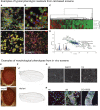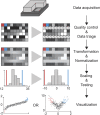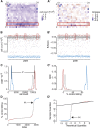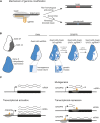RNA Interference (RNAi) Screening in Drosophila
- PMID: 29487145
- PMCID: PMC5844339
- DOI: 10.1534/genetics.117.300077
RNA Interference (RNAi) Screening in Drosophila
Abstract
In the last decade, RNA interference (RNAi), a cellular mechanism that uses RNA-guided degradation of messenger RNA transcripts, has had an important impact on identifying and characterizing gene function. First discovered in Caenorhabditis elegans, RNAi can be used to silence the expression of genes through introduction of exogenous double-stranded RNA into cells. In Drosophila, RNAi has been applied in cultured cells or in vivo to perturb the function of single genes or to systematically probe gene function on a genome-wide scale. In this review, we will describe the use of RNAi to study gene function in Drosophila with a particular focus on high-throughput screening methods applied in cultured cells. We will discuss available reagent libraries and cell lines, methodological approaches for cell-based assays, and computational methods for the analysis of high-throughput screens. Furthermore, we will review the generation and use of genome-scale RNAi libraries for tissue-specific knockdown analysis in vivo and discuss the differences and similarities with the use of genome-engineering methods such as CRISPR/Cas9 for functional analysis.
Keywords: Drosophila; FlyBook; RNAi; bioinformatics; functional genomics; genome engineering; high-throughput screening; image-based screening.
Copyright © 2018 Heigwer et al.
Figures







Similar articles
-
High-throughput functional genomics using CRISPR-Cas9.Nat Rev Genet. 2015 May;16(5):299-311. doi: 10.1038/nrg3899. Epub 2015 Apr 9. Nat Rev Genet. 2015. PMID: 25854182 Free PMC article. Review.
-
Tissue-Specific CRISPR-Cas9 Screening in Drosophila.Methods Mol Biol. 2022;2540:157-176. doi: 10.1007/978-1-0716-2541-5_7. Methods Mol Biol. 2022. PMID: 35980577
-
Identifying synthetic lethal targets using CRISPR/Cas9 system.Methods. 2017 Dec 1;131:66-73. doi: 10.1016/j.ymeth.2017.07.007. Epub 2017 Jul 12. Methods. 2017. PMID: 28710008
-
A Perspective on the Future of High-Throughput RNAi Screening: Will CRISPR Cut Out the Competition or Can RNAi Help Guide the Way?J Biomol Screen. 2015 Sep;20(8):1040-51. doi: 10.1177/1087057115590069. Epub 2015 Jun 5. J Biomol Screen. 2015. PMID: 26048892 Review.
-
RNA Interference Screening for Genes Regulating Drosophila Muscle Morphogenesis.Methods Mol Biol. 2019;1889:331-348. doi: 10.1007/978-1-4939-8897-6_20. Methods Mol Biol. 2019. PMID: 30367424
Cited by
-
Exogenous administration of dsRNA for the demonstration of RNAi in Maruca vitrata (lepidoptera: crambidae).3 Biotech. 2021 Apr;11(4):197. doi: 10.1007/s13205-021-02741-8. Epub 2021 Mar 27. 3 Biotech. 2021. PMID: 33927988 Free PMC article.
-
Drosophila Model in Cancer: An Introduction.Adv Exp Med Biol. 2019;1167:1-14. doi: 10.1007/978-3-030-23629-8_1. Adv Exp Med Biol. 2019. PMID: 31520346 Review.
-
Adult expression of Semaphorins and Plexins is essential for motor neuron survival.Sci Rep. 2023 Apr 11;13(1):5894. doi: 10.1038/s41598-023-32943-4. Sci Rep. 2023. PMID: 37041188 Free PMC article.
-
Light-Induced Protein Clustering for Optogenetic Interference and Protein Interaction Analysis in Drosophila S2 Cells.Biomolecules. 2019 Feb 12;9(2):61. doi: 10.3390/biom9020061. Biomolecules. 2019. PMID: 30759894 Free PMC article.
-
Combined use of feature engineering and machine-learning to predict essential genes in Drosophila melanogaster.NAR Genom Bioinform. 2020 Jul 22;2(3):lqaa051. doi: 10.1093/nargab/lqaa051. eCollection 2020 Sep. NAR Genom Bioinform. 2020. PMID: 33575603 Free PMC article.
References
-
- Ameres S. L., Zamore P. D., 2013. Diversifying microRNA sequence and function. Nat. Rev. Mol. Cell Biol. 14: 475–488. - PubMed
Publication types
MeSH terms
Substances
LinkOut - more resources
Full Text Sources
Other Literature Sources
Medical
Molecular Biology Databases

